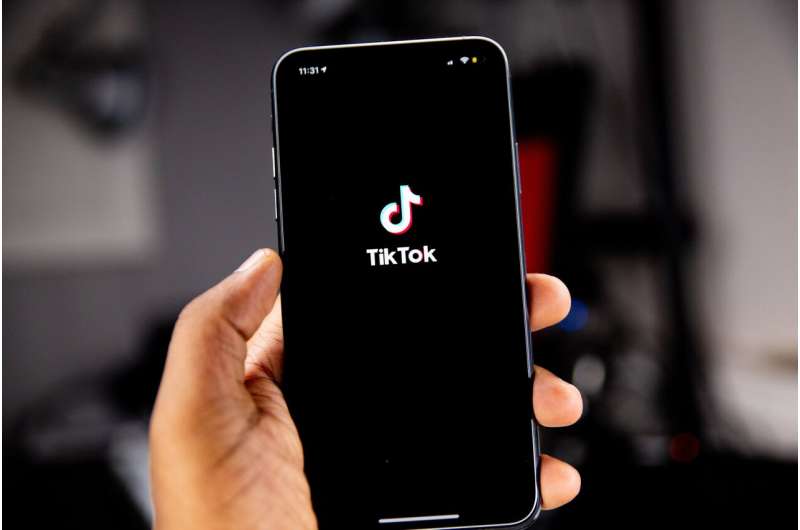This article has been reviewed according to Science X's editorial process and policies. Editors have highlighted the following attributes while ensuring the content's credibility:
fact-checked
trusted source
written by researcher(s)
proofread
TikTok's duet, green screen and stitch turn political point-scoring into an art form

Since its astronomical rise in popularity during the 2020 COVID-19 lockdowns, TikTok has played an increasing role in all aspects of American life, including politics, from the White House briefing key TikTok creators on the war in Ukraine to Joe Biden's presidential campaign launching a TikTok account.
The U.S. House of Representatives passed legislation on March 13, 2024, seeking to force TikTok's China-based parent company to sell the app or face a ban in the U.S. Even if this legislation passes the Senate and Biden signs it into law, it's unlikely TikTok will go away before the 2024 U.S. presidential election. Any law banning TikTok is likely to be challenged in court, and the app won't simply disappear from people's phones overnight.
Given that TikTok is almost certain to play a role in the 2024 election, it's important to examine how TikTok helps shape political expression and discussion. With communications scholar Mackenzie Quick, I recently published a journal article exploring how American TikTok users use the app's stitch, duet and green screen features to stoke partisan conflict.
Getting together
TikTok says its mission is to "inspire creativity and bring joy." In 2019, it introduced several features to help bolster that mission: duet, green screen and stitch. Duet allows you to post your video side by side with a video from another TikTok user. Green screen allows you to superimpose your video on a video from another TikTok user. Stitch allows you to append your video to the end of a short clip from a video from another TikTok user.
TikTok describes these features as giving users "the most creative tools available" and providing a way for users "to engage with the world of content that's made … by the ever-creative TikTok community." Given these descriptions, it appears that these tools were designed to increase creativity, interaction and connections.
They can be used in playful ways or used by subject matter experts to convey information. For example, some veterinarians use TikTok to convey pet health information.
However, a platform's statements about how it intends its features to be used and how people actually use them can be quite different. While these features are often used in TikTok's preferred ways, our research found that in political tiktoks, people often used the tools to double down on their political positions and attack those who don't agree with them. In a time of volatile political divisiveness, these features can function as outlets for people to express their strongly held political views.
Scoring points
Reinforcement and insults were recurring themes in our study. For instance, the green screen feature was often used to incorporate "evidence" in the background to support the creator's claims. With this feature, "evidence" was often presented in the form of news articles or posts from other social media platforms.
One post from a conservative-leaning creator features a screenshot of the Apple iTunes music store charts to show the popularity of a song called "Let's Go Brandon," a conservative rallying cry and coded insult against Biden. This creator presents the song's position at No. 1 in the music store as proof that the conservative viewpoint is popular. "Evidence" is a loose term and could be anything that supported the creator's viewpoint.
We found the duet feature was often used to communicate nonverbally, often to poke fun at someone with opposing political views. Eye rolling, smirking and head shaking were common gestures. In one video, a conservative creator starts a chain—an extended succession of duets—of women who support former President Donald Trump. A liberal-leaning creator uses the duet feature to join the chain with video of themselves holding a clothes iron out to the side to make it appear as though the iron is burning the original creator's hand.
Stitches functioned similarly to duets, but people tended to use the feature as a chance to verbally respond and refute the previous creator's point. These uses show that on political TikTok, personal feelings and proving others wrong matter more than constructive debate.
The who and why of political TikTok
While regulation of the app is a political issue, understanding how political conversations occur across TikTok remains important for understanding an increasingly polarized American electorate. When considering political discussions on TikTok, however, it's important to remember that the app's features don't force users to do anything. Users actively shape their experiences in digital spaces.
Also, as political communication scholars Daniel Kreiss and Shannon McGregor note, it's important to proceed with caution when discussing the effects of technology on polarization because not all groups experience polarization the same way. For instance, the Black Lives Matter movement may be seen as polarizing for disrupting existing power structures, but its goal is to fight for equality, and it's important to consider that context when looking at the group's use of technology.
The lesson is to consider who is engaging in polarizing content and why they are doing so. While some users expressing themselves via these TikTok features aim to simply prove others wrong, akin to petty arguments, others may be critiquing and challenging the powerful.
This article is republished from The Conversation under a Creative Commons license. Read the original article.![]()




















